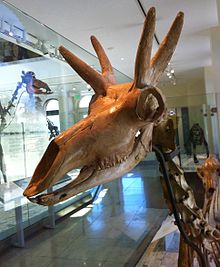

| Antilocapridae
| |
|---|---|

| |
| Pronghorns in Fort Keogh, Montana | |
| Scientific classification | |
| Domain: | Eukaryota |
| Kingdom: | Animalia |
| Phylum: | Chordata |
| Class: | Mammalia |
| Order: | Artiodactyla |
| Suborder: | Ruminantia |
| Infraorder: | Pecora |
| Family: | Antilocapridae J. E. Gray, 1866 |
| Type genus | |
| Antilocapra Ord, 1815 | |
| Genera | |
|
See text | |
The Antilocapridae are a family of ruminant artiodactyls endemic to North America. Their closest extant relatives are the giraffids.[1] Only one species, the pronghorn (Antilocapra americana), is living today; all other members of the family are extinct. The living pronghorn is a small ruminant mammal resembling an antelope.
In most respects, antilocaprids resemble other ruminants. They have a complex, four-chambered stomach for digesting tough plant matter, cloven hooves, and small, forked horns. Their horns resemble those of the bovids, in that they have a true horny sheath, but, uniquely, they are shed outside the breeding season, and subsequently regrown. Their lateral toes are even further diminished than in bovids, with the digits themselves being entirely lost, and only the cannon bones remaining. Antilocaprids have the same dental formula as most other ruminants: 0.0.3.33.1.3.3.
The antilocaprids are ruminants of the clade Pecora. Other extant pecorans are the families Giraffidae (giraffes), Cervidae (deer), Moschidae (musk deer), and Bovidae (cattle, goats and sheep, wildebeests and allies, and antelopes). The exact interrelationships among the pecorans have been debated, mainly focusing on the placement of Giraffidae, but a large-scale ruminant genome sequencing study in 2019 suggested that Antilocapridae are the sister taxon to Giraffidae, as shown in the cladogram below.[2]
The ancestors of pronghorn diverged from the giraffids in the Early Miocene.[2] This was in part of a relatively late mammal diversification following a climate change that transformed subtropical woodlands into open savannah grasslands.[2]
The antilocaprids evolved in North America, where they filled a niche similar to that of the bovids that evolved in the Old World. During the Miocene and Pliocene, they were a diverse and successful group, with many different species. Some had horns with bizarre shapes, or had four, or even six, horns. Examples include Osbornoceros, with smooth, slightly curved horns, Paracosoryx, with flattened horns that widened to forked tips, Ramoceros, with fan-shaped horns, and Hayoceros, with four horns.[3][4]

| Antilocapridae |
|
|---|---|
| Authority control databases: National |
|
|---|